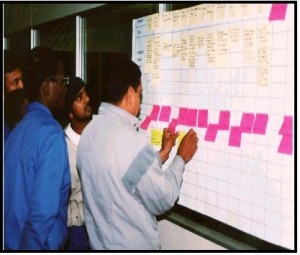Create Enquiring Minds
 The tools for developing the thinking skills of your employees will be under your nose, at your fingertips, or even hanging on your wall. You can begin to build or improve employee thinking skills and job performance with little or no cost to your business. Generally factories have a wealth of charts, pictures, graphs, processes etc. on the walls but most employees mumble when asked what these visuals are. Employees have little say on what information is displayed so no feeling of ownership and little interest. Here a team is busy creating a map to help them visually display the process they follow during a product change on their line. They used it to come up with ideas to improve a changeover process resulting in a reduced in time (56%) and reduction of start-up waste of 73%.
The tools for developing the thinking skills of your employees will be under your nose, at your fingertips, or even hanging on your wall. You can begin to build or improve employee thinking skills and job performance with little or no cost to your business. Generally factories have a wealth of charts, pictures, graphs, processes etc. on the walls but most employees mumble when asked what these visuals are. Employees have little say on what information is displayed so no feeling of ownership and little interest. Here a team is busy creating a map to help them visually display the process they follow during a product change on their line. They used it to come up with ideas to improve a changeover process resulting in a reduced in time (56%) and reduction of start-up waste of 73%.
A number of people responded to our last newsletter asking for more information about using the brainpower of your teams to solve problems. It’s easy to talk about getting teams to think but how is it done in practice. First you must realise that you are trying to change a culture and that is going to take time. There is no quick fix. Some hints on how to simplify the process are…
- Make thinking visible.
- Encourage team members to write down or draw their improvement ideas or problems. It may help to have a standard idea form and problem form.
- Use photo’s – remember a picture says a thousand words. Use arrows and captions to explain the photo.
- Use notice boards to display the ideas and problems. The more people who see the notice board the better.
- Allow everyone to write their comments on the ideas displayed this way you can brainstorm over shifts.
- Reward or recognise ideas that deliver sustainable results or financial benefits.
- Challenge the team. Get them to solve specific problems starting with relatively simple ones progressing in difficulty.
- Teach teams simple problem solving tools
- Make a habit of asking questions. (5 Why analysis)
- Use a Matrix – not only is it good for gathering and sorting information but it also inspires creative thinking and problem solving.
- Involve the team in practically testing and communicating their ideas.
Given the chance people naturally try to improve their lives and make their work easier. All your teams need are the tools to help them improve and lots of support. The results will be amazing and sustainable.

